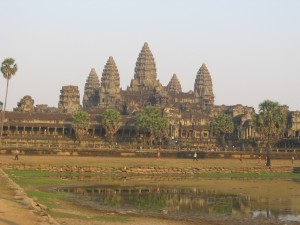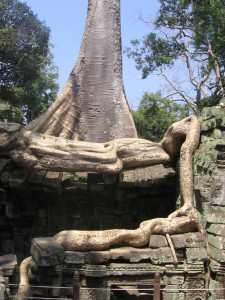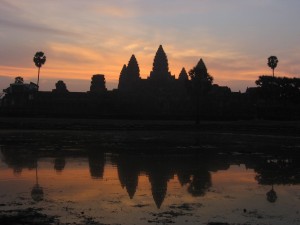Toward the end of our Thailand tour and after our tropical idyll on Koh Ngai we flew to Siem Reap, gateway to magnificent Angkor Wat. Angkor is certainly the mother of all Southeast Asian sights: a jaw-dropping collection of ancient stone temples, carved walls and gates, monasteries, and reservoirs, built by the Khmer civilization from about 900 to 1300AD. We had two full days there, which was barely enough to see the top temples: Angkor Wat, Angkor Thom, Ta Prohm, and Banteay Srei. Unfortunately, those top sights are the ones 95% of all visitors are crowding into. The resource is being loved to death I fear. When I brought my first group here in 2008, Angkor attracted a half million visitors. Last year the number was 2.3 million. This year they predict 3 million and 5 million by 2015. Wow! I guess my message is: go soon! It is certainly only a matter of time before the opportunity to climb in, on, and through the temples, one of the real highlights of being here, is restricted.
Our guide Songkuang, whom we called Kjen, helped make our experience of Angkor exceptional. On our first day, we took on the biggies: Angkor Wat and Thom. We started with AW, by some measures the largest religious building in the world. It is massive with its soaring corncob towers. It is made even more impressive by the fact that when it was built in the early 12th century, most Europeans were living in huts and the biggest buildings by far were the earliest Gothic cathedrals of northern France - which pale in comparisons of scale. Almost every inch of the complex is covered in exquisite sculptures. Carved stone pavilions, views
We started with AW, by some measures the largest religious building in the world. It is massive with its soaring corncob towers. It is made even more impressive by the fact that when it was built in the early 12th century, most Europeans were living in huts and the biggest buildings by far were the earliest Gothic cathedrals of northern France - which pale in comparisons of scale. Almost every inch of the complex is covered in exquisite sculptures. Carved stone pavilions, views through spindled windows, and niches containing active alters attended by monks add to the special ambiance. However, I feel compelled to observe, what makes AW truly massive is the concentric, galleried walls that surround the main temple complex. The first, outer wall is almost exactly a mile around. And that wall is surrounded by a large moat – impressive. Kjen pointed out bullet holes from Khmer Rouge occupation, explained the functions of various galleries
through spindled windows, and niches containing active alters attended by monks add to the special ambiance. However, I feel compelled to observe, what makes AW truly massive is the concentric, galleried walls that surround the main temple complex. The first, outer wall is almost exactly a mile around. And that wall is surrounded by a large moat – impressive. Kjen pointed out bullet holes from Khmer Rouge occupation, explained the functions of various galleries and temple sections, and interpreted the messages contained in the bas relief sculptures that stretch hundreds of yards around the complex. We saw the churning of the sea milk (Hindu creation mythology) and the official state propaganda "story" of Suryavarman II, builder of AW. I also enjoyed Kjen's explanation of the confusing Hindu vs. Buddhist issue. When the first temples of Angkor were started, the Khmer kingdom was Hindu. But over the next 4-5 centuries, as the empire
and temple sections, and interpreted the messages contained in the bas relief sculptures that stretch hundreds of yards around the complex. We saw the churning of the sea milk (Hindu creation mythology) and the official state propaganda "story" of Suryavarman II, builder of AW. I also enjoyed Kjen's explanation of the confusing Hindu vs. Buddhist issue. When the first temples of Angkor were started, the Khmer kingdom was Hindu. But over the next 4-5 centuries, as the empire  expanded successive rulers added temples, each wanting to demonstrate his greatness and leave a lasting legacy in stone - much like the Romans in the west. Over that time, some rulers adopted Buddhism. So some temples are Hindu, others Buddhists. Moreover, sometimes, if resources were available, a Hindu king might replace all the Buddha statues from a previously built temple with Hindu deities - or vice versa. Also, as Buddhism evolved out of Hinduism in 3-4th century BC India, they share many fundamental icons, deities, heroes, symbols, and mythologies. So basically, Angkor is a mixed bag – but great fun to sort.
expanded successive rulers added temples, each wanting to demonstrate his greatness and leave a lasting legacy in stone - much like the Romans in the west. Over that time, some rulers adopted Buddhism. So some temples are Hindu, others Buddhists. Moreover, sometimes, if resources were available, a Hindu king might replace all the Buddha statues from a previously built temple with Hindu deities - or vice versa. Also, as Buddhism evolved out of Hinduism in 3-4th century BC India, they share many fundamental icons, deities, heroes, symbols, and mythologies. So basically, Angkor is a mixed bag – but great fun to sort.
 After a midday break for lunch, and maybe a quick dip in the pool, we returned to visit Angkor Thom - a walled city that contains several temples. The first impressive sight is entering one of the four main gates - each topped by a massive tower, carved with four Khmer faces facing the cardinal points of the compass. Each gate is reached by a bridge that crosses a moat, the balustraded sides of which are huge stone statues, depicting the Churning of the Sea Milk story once again.
After a midday break for lunch, and maybe a quick dip in the pool, we returned to visit Angkor Thom - a walled city that contains several temples. The first impressive sight is entering one of the four main gates - each topped by a massive tower, carved with four Khmer faces facing the cardinal points of the compass. Each gate is reached by a bridge that crosses a moat, the balustraded sides of which are huge stone statues, depicting the Churning of the Sea Milk story once again.  Once inside, we headed to the major attraction: Bayon temple. Kjen told us this was his favorite and I'd be hard pressed to disagree. Much more a human scale that Angkor Wat, Bayon literally bristles with dozens of towers, each with four Khmer faces for a total of 216 faces. Additionally, the entire complex is covered in lichens, giving the place a more ancient, even alien feel. It is a fantastic temple and great fun to explore its more intimate but labyrinthine
Once inside, we headed to the major attraction: Bayon temple. Kjen told us this was his favorite and I'd be hard pressed to disagree. Much more a human scale that Angkor Wat, Bayon literally bristles with dozens of towers, each with four Khmer faces for a total of 216 faces. Additionally, the entire complex is covered in lichens, giving the place a more ancient, even alien feel. It is a fantastic temple and great fun to explore its more intimate but labyrinthine  galleries, windows, and aforementioned towers. It is certainly the most photogenic temple of Angkor.
galleries, windows, and aforementioned towers. It is certainly the most photogenic temple of Angkor.
After the Bayon, we walked five minutes to the nearby Terrace of the Leper King and Terrace of the Elephants. These terraces were the foundations for the royal reception pavilions of Angkor Thom. It is aptly named for the relief sculptures that decorate its facade. I love the way the carved elephants only become obvious when you look for a while.  The obscurity is due to the deterioration of time. But once you identify them, they are clear enough to see. There is one section that is decorated with Garudas, the mythical bird vehicle (or steed) of Vishnu. These huge stone versions are essentially the same style and motif as the ornamental bronze versions we had seen in Bangkok's Wat Phra Kheo at the beginning of the tour. I call them the Zumba Garudas – all lined up with their “hands” in the air.
The obscurity is due to the deterioration of time. But once you identify them, they are clear enough to see. There is one section that is decorated with Garudas, the mythical bird vehicle (or steed) of Vishnu. These huge stone versions are essentially the same style and motif as the ornamental bronze versions we had seen in Bangkok's Wat Phra Kheo at the beginning of the tour. I call them the Zumba Garudas – all lined up with their “hands” in the air.
 Our second full day in Cambodia began with a much needed free morning. Then the group split: about half joined me for an extracurricular excursion to Kbal Spean (see my next blog) and the other had lunch with Kjen. Both groups started their afternoon sightseeing with a stop at Ta Prohm. Ta Prohm is probably Angkor’s most intriguing sight, perhaps even more popular that Angkor Wat itself. This is the complex archaeologists elected to leave as they found: overwhelmed by the jungle. They hacked back enough for access but left the trees which had taken over the walls and buildings. This is the quintessential Tomb Raider/Indiana Jones sight.
Our second full day in Cambodia began with a much needed free morning. Then the group split: about half joined me for an extracurricular excursion to Kbal Spean (see my next blog) and the other had lunch with Kjen. Both groups started their afternoon sightseeing with a stop at Ta Prohm. Ta Prohm is probably Angkor’s most intriguing sight, perhaps even more popular that Angkor Wat itself. This is the complex archaeologists elected to leave as they found: overwhelmed by the jungle. They hacked back enough for access but left the trees which had taken over the walls and buildings. This is the quintessential Tomb Raider/Indiana Jones sight. I try not to overuse the word awesome in my descriptions but this place is AWESOME! Thousand year old walls and stone temple buildings completely overwhelmed by the gigantic root systems of the Strangler Fig and Silk Cotton trees – its literally jaw-dropping. Since my last visit they have built wooden walkways throughout the complex to lessen the impact of the tourist hoards. But it serves to restrict the movement of said hoards and therefore concentrates the crowds at key points even more than usual. But honestly, sharing the experience with thousands of other tourists does not lessen the grandeur, only makes for more challenging photographs if one’s goal is a shot without people.
I try not to overuse the word awesome in my descriptions but this place is AWESOME! Thousand year old walls and stone temple buildings completely overwhelmed by the gigantic root systems of the Strangler Fig and Silk Cotton trees – its literally jaw-dropping. Since my last visit they have built wooden walkways throughout the complex to lessen the impact of the tourist hoards. But it serves to restrict the movement of said hoards and therefore concentrates the crowds at key points even more than usual. But honestly, sharing the experience with thousands of other tourists does not lessen the grandeur, only makes for more challenging photographs if one’s goal is a shot without people.

 Our afternoon concluded with the two groups reuniting at Banteay Srei, one of my favorite temples. It is a much older temple and is quite far out from the rest of Angkor. These temples were built over a thousand years ago. The scale is much less grandiose than Angkor Wat or Thom but what is lacking in size is compensated by detail. Angkor’s best stone carving is on display here. Also, the natural red of the stones virtually glows in the last light of the afternoon. Picturesque moats complete the ambiance and provide reflective photographs. To break up our long drive back to Siem Reap we stopped for sunset at an outlying temple, Pre Rup. Tourists gather here to enjoy the sunset over the jungle, the tiny silhouette of Angkor Wat barely discernible in the distance.
Our afternoon concluded with the two groups reuniting at Banteay Srei, one of my favorite temples. It is a much older temple and is quite far out from the rest of Angkor. These temples were built over a thousand years ago. The scale is much less grandiose than Angkor Wat or Thom but what is lacking in size is compensated by detail. Angkor’s best stone carving is on display here. Also, the natural red of the stones virtually glows in the last light of the afternoon. Picturesque moats complete the ambiance and provide reflective photographs. To break up our long drive back to Siem Reap we stopped for sunset at an outlying temple, Pre Rup. Tourists gather here to enjoy the sunset over the jungle, the tiny silhouette of Angkor Wat barely discernible in the distance.

